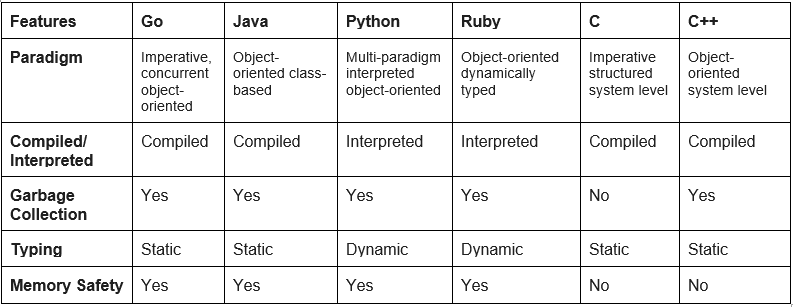Introduction to Golang Programming Language
Golang also known as Go is a free and open-source programming language developed by Google. Developers use this language to develop software, web applications, and cloud and networking services. Golang has a fast run time and can be installed and run without a virtual machine. This language is specifically designed for solving the problems like uncontrolled dependencies, difficulty in writing automatic tools, and slow build time.
Know more information about the Golang in this guide.
Introduction to Golang Programming Language
Golang is an alternative to C++ developed in 2007 by Robert Griesemer and announced in 2009. It has all the useful characteristics of other languages yet is easy to use and learn. In Golang, packages are used for managing dependencies and assembling programs.
Golang is a famous and popular programming language, and one of its key features is its concurrency support. Developers can run multiple programs simultaneously using goroutines and channels. Goroutines are lightweight threads of execution that allow multiple functions to be executed concurrently within a single program. They are created using the “go” keyword followed by the function name. Channels on the other hand are communication mechanisms that enable goroutines to communicate and synchronize their operations.
In Golang, there is a set of packages called the standard library, which contains a collection of tools to perform common programming tasks, like handling files, networking, and encryption. Further, developers can use external packages from the Go module repository to enhance their code with more functionalities.
A number of widely used applications and services, such as Docker, Netflix, Dropbox, and OpenShift, have been created with Golang.
How to Write Code in Golang
To write a code in Golang first install the compiler or use it online. Follow the below steps to write a code in Golang:
Step 1: Install the Go compiler file that is compatible with your system through this official link:

Step 2: Once the file is downloaded open the file to install it:

Step 3: Verify the installation by running the following command in the command prompt:

Step 4: Next open Notepad or Notepad++ by searching it in the start menu:

Step 5: Start writing the code in Notepad, the following is the sample Golang code:
import "fmt"
func main() {
fmt.Println("hello and Welcome to Golang Tutorial!")
}
In the above code the:
-
- The first line is the main package of the program which is compulsory to write.
- The second statement contains import fmt, which is the preprocessor command for compiling the files of the program.
- Next, the main function is the start the execution of the program.
- fmt.Println() is used for printing statements on the screen.
Step 6: Save the file on your system:

Step 7: Open the command prompt and execute the following command to run the above code:
Here I am executing the run command to get the output of the sample.go file that I have created:

What are the Benefits of the Golang
The following are the benefits of the Golang:
-
- Fast compilation and execution speed.
- Can be compiled into machine code without the need for a virtual machine.
- Provides excellent concurrency support.
- Memory-safe programming with automatic garbage collection.
- Large standard library and a growing package ecosystem.
- Independent error handling using Go’s built-in error type.
- Strong type system with type embedding and interfaces.
- A simple syntax that is easy to learn and read.
- Statically typed language where types are determined at compile time, not runtime.
What are the Limitations of Golang
Like other languages, Golang also has some drawbacks:
-
- It doesn’t have advanced safety features found in other languages, like runtime exceptions.
- It supports object-oriented programming concepts like interfaces and composition, but it doesn’t have classes like traditional object-oriented languages.
- There are some libraries that you may not find in Golang like the UI toolkit.
Comparison of Golang with Other Languages
Golang is the best choice as compared to the other languages as it reduces the amount of typing. There is no declaration of header files, everything is declared once, and there is no type hierarchy in Golang.
Below is the table of general comparison of Golang with other languages:

Final Thoughts
Golang is an open-source, compiled programming language developed by Google; it is known for its clean and concise syntax, built-in support for concurrency, and fast compilation times. The language also has its own garbage collection mechanism, making it an ideal choice for networked applications and other performance-critical software. The above-mentioned guidelines will help users understand the basics of Golang.
Source: linuxhint.com
